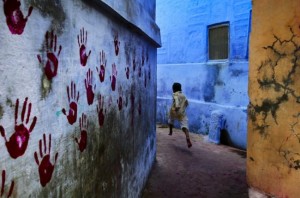People of all ages learn through stories, and you can bring lessons about nonviolence into the classroom through the art of storytelling. Consider memorizing a story about nonviolence, either from real life or made up, and try telling it without reading from a book so you engage more with the students in front of you. You might also begin with an image or a photograph. Pass it around and then tell them that you will tell a story about that photo… Don’t forget to get creative: use different voices, incorporate song and movement, and follow their interest with improvisation where possible.
Here is one that I learned that originates in India, which I heard in a talk given by the late meditation teacher, Sri Eknath Easwaran:
 One sunny day, a sage, or wise person, was sitting underneath a tree for shade, with a delicious yet simple lunch of potatoes and chapati (a kind of Indian bread) spread out on a banyan leaf before him. He closed his eyes to say his blessing and express his gratitude for his food.
One sunny day, a sage, or wise person, was sitting underneath a tree for shade, with a delicious yet simple lunch of potatoes and chapati (a kind of Indian bread) spread out on a banyan leaf before him. He closed his eyes to say his blessing and express his gratitude for his food.
A little boy spotted the sage with his eyes closed. The little boy did not have any food for lunch or any money to buy any. He thought to himself, “If that man will not eat his food quickly enough, sitting there all day with his eyes closed, I will eat his food for him.” He tiptoed over stealthily to where the sage was sitting and grabbed the chapati.
The sage opened his eyes, and startled the boy, who began running away, chapati still in hand. As he was in excellent physical condition, the sage jumped up and began running after him. He finally caught up with the boy who was frightened. He did not expect that an old sage would be able to catch up to him!
Trembling, he held out his hands with the chapati, and said in a quiet voice, “Here are your chapati, are you going to hit me?”
The sage laughed, “Hit you? What do you mean? Look here, I’ve brought you the potatoes. You cannot eat chapati without potatoes.”
As the boy ate his meal, the sage smiled. He was happy.
After you tell the story in your own way to the children, make sure to ask them questions about what happened, any lessons we can learn, and other nonviolence related take aways.








